Analysis of Spatial and Temporal Changes in Vegetation Cover and Driving Forces in the Yan River Basin, Loess Plateau
Abstract
:1. Introduction
2. Study Area and Data Sources
2.1. Study Area
2.2. Data Sources
3. Methodology
3.1. Three-Dimensional Vegetation Cover Model
3.2. Accuracy Assessment Method of Vegetation Cover
3.3. Theil–Sen Median and Mann–Kendall Methods
3.4. Coefficient of Variation
3.5. Hurst Index
3.6. Geodetector
4. Results and Analysis
4.1. Quantitative Comparative Analysis of 3DFVC and FVC
4.2. Characteristics of Temporal Changes in Vegetation Cover in the Yanhe River Basin and Its Counties, 2001–2020
4.2.1. Temporal Trends in Vegetation Cover in the Yanhe River Basin
4.2.2. Temporal Trends in Vegetation Classes in the Yanhe River Basin
4.2.3. Temporal Trends in Vegetation Cover of Counties in the Yanhe River Basin
4.3. Spatial Distribution and Change Characteristics of Vegetation Cover in the Yanhe River Basin, 2001–2020
4.3.1. Spatial Distribution Patterns of Vegetation Cover in the Yanhe River Basin, 2001–2020
4.3.2. Spatial and Temporal Pattern of Vegetation Change and Its Future Trend in the Yanhe River Basin, 2001–2020
4.4. Analysis of Factors Influencing Vegetation Cover
4.4.1. Factor Detector
4.4.2. Interaction Detector and Ecological Detector
4.4.3. Risk Detector
5. Discussion
5.1. Impacts of Climate Change on Vegetation Cover Change
5.2. Impact of Human Activities on Changes in Vegetation Cover
5.3. Suitable Intervals for Vegetation Growth
5.4. Limitations and Prospects
6. Conclusions
- Three-dimensional FVC has better accuracy than FVC. Three-dimensional FVC has higher regression coefficients and lower RMSE, which indicates that 3DFVC is better than FVC in vegetation cover extraction. In addition, 3DFVC is better than FVC for the Yanhe River Basin, which has complex topography.
- The FVC in the Yan River Basin varied significantly over time from 2001 to 2020, with an overall significant but gradually increasing trend (S = 0.01/a, p < 0.01). The year 2013 was identified as the time change point. The overall FVC increased significantly and rapidly before 2013 (S = 0.0152/a, p < 0.01) and showed a significant slow-increasing trend after 2013 (S = 0.0015/a). We found that the vegetation cover in the Yan River Basin improved significantly, as shown by the increasing proportion of areas with high and relatively high FVC. The main reason for the increase in vegetation cover was the enhanced growth of medium FVC. Among the counties (districts), the FVC in Ansai District had the fastest growth rate in 20 years and presented a highly significant growth trend, while Jingbian County had the slowest growth rate.
- Our analysis of the spatial distribution of FVC within the Yan River Basin from 2001 to 2020 revealed a pattern of gradually increasing spatial distribution from north to south, with significant differences observed between these regions. High-value areas were primarily located in Zhidan County, southern Ansai District, southern Baota District, and the eastern and western parts of southern Yanchang County, with Yanchang County exhibiting the most favorable vegetation cover. We found that the FVC of all counties (districts) in the Yan River Basin mainly increased, as shown in 83.9% of the area, especially in the upper and middle reaches. This indicates the effectiveness of the project of returning farmland to forest and grassland. The FVC in the river basin fluctuated considerably over the past two decades, and our analysis suggests that the FVC in the Yan River Basin will likely increase further in the future.
- The main factors causing spatial variation in FVC from 2001 to 2020 were relative humidity and rainfall, which had an explanatory power of over 25%. The spatial variation in the imaged FVC was mainly influenced by climate factors. Anthropogenic LUCC (mainly decreasing arable and grassland areas and increasing forest areas) was also a key driver of spatial and temporal changes in vegetation cover and differences. Most of the interactions between drivers were linear or nonlinear enhancement, with the strongest interaction being relative humidity and land use, which explained 35.4% of the variation. The suitable growth conditions for Yan River Basin vegetation included low sunlight, high rainfall, high humidity, 1088–1205 m elevation, 22–27° slope, black clay soil, low population density, low GDP, and shrub land use type.
Author Contributions
Funding
Data Availability Statement
Conflicts of Interest
References
- Jin, K.; Wang, F.; Han, J.; Shi, S.; Ding, W. Contribution of climatic change and human activities to vegetation NDVI change over China during 1982–2015. Acta Geogr. Sin. 2020, 75, 961–974. [Google Scholar]
- Gitelson, A.A.; Kaufman, Y.J.; Stark, R.; Rundquist, D. Novel algorithms for remote estimation of vegetation fraction. Remote Sens. Environ. 2002, 80, 76–87. [Google Scholar] [CrossRef]
- Liu, M.; Liu, Y.; Chen, M.; Li, Q.; Liang, Q.; Zou, J.; Qiaolipanguli, T. Spatiotemporal Evolution of Vegetation Coverage and Its Response to Climate Change in Upper Reaches of Ganjiang River Basin during 2000–2018. Bull. Soil Water Conserv. 2020, 40, 284–290. [Google Scholar]
- Guo, M.; Zhang, T.; Zhang, J.; Chen, L.; Zhang, X. Response of Vegetation Coverage to Climate Change in the Loess Plateau in 1982–2006. Res. Soil Water Conserv. 2014, 21, 35–40, 48. [Google Scholar]
- Wang, H.; Chen, W.; He, L.; Li, H. Responses of aquatic vegetation coverage to interannual variations of water level in different hydrologically connected sub -lakes of Poyang Lake, China. Yingyong Shengtai Xuebao 2022, 33, 191–200. [Google Scholar] [PubMed]
- Wang, W.; Hu, P.; Wang, J.; Yang, Z.; Liu, H.; Yang, Q. Response of Vegetation Cover and Structure to Meteorological and Hydrologic Factors in Zhalong Wetland. J. Hydroecol. 2020, 41, 89–97. [Google Scholar]
- Deng, B.; Chen, H.; Li, H.; Lei, S. Influence of dump vegetation coverage and topographic changes on soil and water loss in drainage basin. Coal Sci. Technol. 2022, 50, 299–308. [Google Scholar]
- Xu, H.; He, H.; Huang, S. Analysis of fractional vegetation cover change and its impact on thermal environment in the Hetian basinal area of County Changting, Fujian Province, China. Acta Ecol. Sin. 2013, 33, 2954–2963. [Google Scholar]
- Liu, R.; Xu, L.; Feng, F.; Liu, Y.; Zhang, X. Spatiotemporal Variation of Vegetation Coverage in Wuhai City from 2000 to 2018. Res. Soil Water Conserv. 2022, 29, 265–273. [Google Scholar]
- Qin, W.; Zhu, Q.; Zhang, X.; Li, W.; Fang, B. Review of vegetation covering and its measuring and calculating method. J. Northwest Sci-Tech Univ. Agric. For. 2006, 34, 163–170. [Google Scholar]
- Li, M.; Wu, B.; Yan, C.; Zhou, W. Estimation of Vegetation Fraction in the Upper Basin of Miyun Reservoir by Remote Sensing. Resour. Sci. 2004, 26, 153–159. [Google Scholar]
- Cheng, H.; Zhang, W.; Chen, F. Advances In Researches on Application of Remote Sensing Method to Estimating Vegetation Coverage. Remote Sens. Land Resour. 2008, 20, 13–18. [Google Scholar]
- Peng, W.; Wang, G.; Zhou, J.; Xu, X.; Luo, H.; Zhao, J.; Yang, C. Dynamic monitoring of fractional vegetation cover along Minjiang River from Wenchuan County to Dujiangyan City using multi-temporal landsat 5 and 8 images. Acta Ecol. Sin. 2016, 36, 1975–1988. [Google Scholar]
- Li, D.; Fan, J.; Wang, J. Change characteristics and their causes of fractional vegetation coverage(FVC) in Shaanxi Province. Chin. J. Appl. Ecol. 2010, 21, 2896. [Google Scholar]
- Li, M.; Yan, Q.; Li, G.; Yi, M.; Li, J. Spatio-Temporal Changes of Vegetation Cover and Its Influencing Factors in Northeast China from 2000 to 2021. Remote Sens. 2022, 14, 5720. [Google Scholar] [CrossRef]
- Chen, S.; Wen, Z. Zonal Species Distribution Response to Climate Change in Yanhe River Catchment. J. Soil Water Conserv. 2011, 25, 157–161. [Google Scholar]
- Zhao, J.; Van Oost, K.; Chen, L.; Govers, G. Moderate topsoil erosion rates constrain the magnitude of the erosion-induced carbon sink and agricultural productivity losses on the Chinese Loess Plateau. Biogeosciences 2016, 13, 4735–4750. [Google Scholar] [CrossRef]
- Zhang, F.; Yang, L.; Yang, Y. Change of Vegetation NDVI and Its Response to Climatic and Human Activities in the Loess Plateau During 1981–2016. Res. Soil Water Conserv. 2023, 30, 230–237. [Google Scholar]
- Zhang, C.; Bai, Z.; Li, X.; Ran, Q.; Wei, Z.; Lei, T.; Wang, N. Spatio-temporal evolution and attribution analysis of human effects of vegetation cover on the Loess Plateau from 2001 to 2018. Arid Land Geogr. 2021, 44, 188–196. [Google Scholar]
- Xuan, Y.; Shuai-zhi, K.; Yong-hua, Z.; Lei, H.; Xi-ming, X.; Fan, L. Spatio-temporal relationship between vegetation restoration and ecosystem services in the Loess Plateau of Northern Shaanxi, China. Chin. J. Appl. Ecol. 2022, 33, 2760–2768. [Google Scholar]
- Xie, H.; Tong, X.; Li, J.; Zhang, J.; Liu, P.; Yu, P. Changes of NDVI and EVI and their responses to climatic variables in the Yellow River Basin during the growing season of 2000–2018. Acta Ecol. Sin. 2022, 42, 4536–4549. [Google Scholar]
- Chen, C.; Wang, Y.; Li, Y.; Zhou, S. Vegetation Changes and Influencing Factors in Different Climatic Regions of Yellow River Basin from 1982 to 2015. J. Yangtze River Sci. Res. Inst. 2022, 39, 56–62, 81. [Google Scholar]
- Zhang, J.; Li, C.; Wang, T. Dynamic Changes of Vegetation Coverage on the Loess Plateau and Its Factors. Res. Soil Water Conserv. 2022, 29, 224–230, 241. [Google Scholar]
- Zhang, J.; Hu, A.; Zhang, D. Vegetation coverage variation in Loess Plateau Area of Shaanxi-Gansu-Ningxia. J. Northwestern Teach. Univ. Nat. Sci. Ed. 2021, 57, 71–76. [Google Scholar]
- Maes, J.; Egoh, B.; Willemen, L.; Liquete, C.; Vihervaara, P.; Schagner, J.P.; Grizzetti, B.; Drakou, E.G.; La Notte, A.; Zulian, G.; et al. Mapping ecosystem services for policy support and decision making in the European Union. Ecosyst. Serv. 2012, 1, 31–39. [Google Scholar] [CrossRef]
- Qian, C.; Gong, J.; Zhang, J.; Liu, D.; Ma, X. Change and tradeoffs-synergies analysis on watershed ecosystem services: A case study of BailongjiangWatershed, Gansu. Acta Geogr. Sin. 2018, 73, 868–879. [Google Scholar]
- He, Q.; Wang, M.; Liu, K.; Jiang, Z. GPRChinaTemp1km: A high-resolution monthly air temperature dataset for China (1951–2020) based on machine learning. Copernic. GmbH 2021, 1–29. [Google Scholar] [CrossRef]
- Zhao, N.; Liu, Y.; Cao, G.; Samson, E.L.; Zhang, J. Forecasting China’s GDP at the pixel level using nighttime lights time series and population images. Mapp. Sci. Remote Sens. 2017, 54, 407–425. [Google Scholar] [CrossRef]
- Yang, J.; Huang, X. The 30 m annual land cover dataset and its dynamics in China from 1990 to 2019. Earth Syst. Sci. Data 2021, 13, 3907–3925. [Google Scholar] [CrossRef]
- Yin, D.; Wang, Y. Temporal and spatial changes of vegetation coverage and its topographic differentiation in temperate continental semi-arid monsoon climate region. Acta Ecol. Sin. 2021, 41, 1158–1167. [Google Scholar]
- Qi, J.; Marsett, R.C.; Moran, M.S.; Goodrich, D.C.; Zhang, X.X. Spatial and temporal dynamics of vegetation in the San Pedro River basin area. Agric. For. Meteorol 2000, 105, 55–68. [Google Scholar] [CrossRef]
- Fu, H.; Wang, R.; Wang, X. Analysis of Spatiotemporal Variations and Driving Forces of NDVI in the Yellow River Basin during 1999–2018. Res. Soil Water Conserv. 2022, 29, 145–153, 162. [Google Scholar]
- Nie, T.; Dong, G.; Jiang, X.; Gu, J. Spatiotemporal Variation and Driving Forces of Vegetation Coverage in Yan′an Area. Res. Soil Water Conserv. 2021, 28, 340–346. [Google Scholar]
- Chen, Y.; Wang, W.; Guan, Y.; Liu, F.; Zhang, Y.; Du, J.; Feng, C.; Zhou, Y. An integrated approach for risk assessment of rangeland degradation: A case study in Burqin County, Xinjiang, China. Ecol. Indic. 2020, 113, 106203. [Google Scholar] [CrossRef]
- Sen, P.K. Estimates of the Regression Coefficient Based on Kendall’s Tau. J. Am. Stat. Assoc. 1968, 63, 1379–1389. [Google Scholar] [CrossRef]
- He, T.; Shao, Q. Spatial-temporal Variation of Terrestrial Evapotranspiration in China from 2001 to 2010 Using MOD16 Products. J. Geo-Inf. Sci. 2014, 16, 979–988. [Google Scholar]
- Wang, X.; Shi, S.; Chen, J. Change and driving factors of vegetation coverage in the Yellow River Basin. China Environ. Sci. 2022, 42, 5358–5368. [Google Scholar]
- Hurst, H. Methods of Using Long-Term Storage in Reservoirs. ICE Proc. 1956, 5, 519–543. [Google Scholar] [CrossRef]
- Nie, T.; Dong, G.; Jiang, X.; Lei, Y. Spatio-Temporal Changes and Driving Forces of Vegetation Coverage on the Loess Plateau of Northern Shaanxi. Remote Sens. 2021, 13, 613. [Google Scholar] [CrossRef]
- Wang, J.; Xu, C. Geodetector: Principle and prospective. Acta Geogr. Sin. 2017, 72, 116–134. [Google Scholar]
- Du, J.; Fu, Q.; Fang, S.; Wu, J.; He, P.; Quan, Z. Effects of rapid urbanization on vegetation cover in the metropolises of China over the last four decades. Ecol. Indic. 2019, 107, 105458. [Google Scholar] [CrossRef]
- Yue, M.; Geng, G.; Wang, T.; Yang, R.; Gu, Q. Spatiotemporal Variation of Vegetation NDVI and Its Driving Factors in theShaanxi Section of the Yellow River Basin from 2000 to 2019. Res. Soil Water Conserv. 2023, 30, 238–246, 255. [Google Scholar]
- He, H.; Wang, Z.; Dong, J.; Wang, J.; Zou, J. Synergy and trade-off between vegetation change and urbanization development in the Yellow River Basin of Shaanxi Province based on satellite remote sensing data. Acta Ecol. Sin. 2022, 42, 3536–3545. [Google Scholar]
- BAO, C.; FANG, C. Impact of Water Resources Exploitation and Utilization on Eco-environment in Arid Area: Progress and Prospect. Prog. Geogr. 2008, 27, 38–46. [Google Scholar]
- Xie, Y.; Xia, Z.; Wang, T.; Zhang, Z.; Zhu, D. Temporal and spatial variation of vegetation net primary product and its response to hydrothermal conditions and grain for green project in the Yellow River basin. Bull. Surv. Mapp. 2023, 0, 15–20. [Google Scholar]
- Chen, S.; Zhang, Q.; Chen, Y.; Zhou, H.; Xiang, Y.; Liu, Z.; Hou, Y. Vegetation Change and Eco-Environmental Quality Evaluation in the Loess Plateau of China from 2000 to 2020. Remote Sens. 2023, 15, 424. [Google Scholar] [CrossRef]
- Guo, B.; Wang, Y.; Pei, L.; Yu, Y.; Liu, F.; Zhang, D.; Wang, X.; Su, Y.; Zhang, D.; Zhang, B.; et al. Determining the effects of socioeconomic and environmental determinants on chronic obstructive pulmonary disease (COPD) mortality using geographically and temporally weighted regression model across Xi’an during 2014–2016. Sci. Total Environ. 2021, 756, 143869. [Google Scholar] [CrossRef]
- Dong, Y.; Yin, D.; Li, X.; Huang, J.; Su, W.; Li, X.; Wang, H. Spatial–Temporal Evolution of Vegetation NDVI in Association with Climatic, Environmental and Anthropogenic Factors in the Loess Plateau, China during 2000–2015: Quantitative Analysis Based on Geographical Detector Model. Remote Sens. 2021, 13, 4380. [Google Scholar] [CrossRef]
- Xie, B.; Jia, X.; Qin, Z.; Shen, J.; Chang, Q. Vegetation dynamics and climate change on the Loess Plateau, China: 1982–2011. Reg. Environ. Chang. 2016, 16, 1583–1594. [Google Scholar] [CrossRef]
- Bueno, M.L.; Rezende, V.L.; De Paula, L.F.A.; Meira-Neto, J.A.A.; Pinto, J.R.R.; Neri, A.V.; Pontara, V. Understanding how environmental heterogeneity and elevation drives the distribution of woody communities across vegetation types within the campo rupestre in South America. J. Mt. Sci.-Engl. 2021, 18, 1192–1207. [Google Scholar] [CrossRef]
- Pu, C.; Xu, Q.; Zhao, K.; Jiang, Y.; Guo, P.; Du, P.; Yuan, S. Remote sensing analysis of land subsidence and vegetation restoration characteristics in excavation and filling areas of mountain region for urban extension in Yan’an. J. Eng. Geol. 2020, 28, 597–609. [Google Scholar]
- Meng, X.; Gao, X.; Li, S.; Lei, J. Spatial and Temporal Characteristics of Vegetation NDVI Changes and the Driving Forces in Mongolia during 1982–2015. Remote Sens. 2020, 12, 603. [Google Scholar] [CrossRef]
- Dumka, U.C. A Long-Term Spatiotemporal Analysis of Vegetation Greenness over the Himalayan Region Using Google Earth Engine. Climate 2021, 9, 109. [Google Scholar]
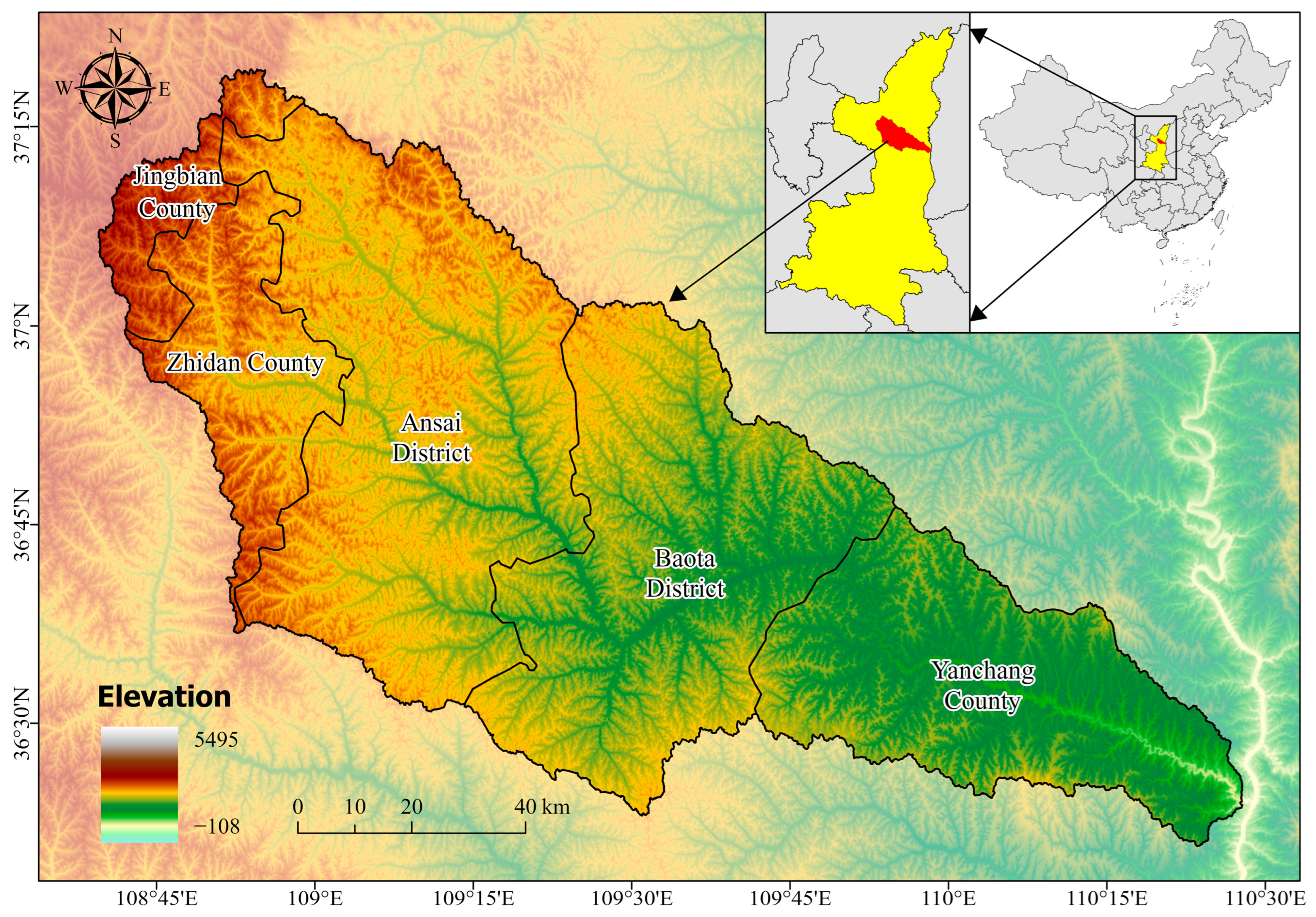

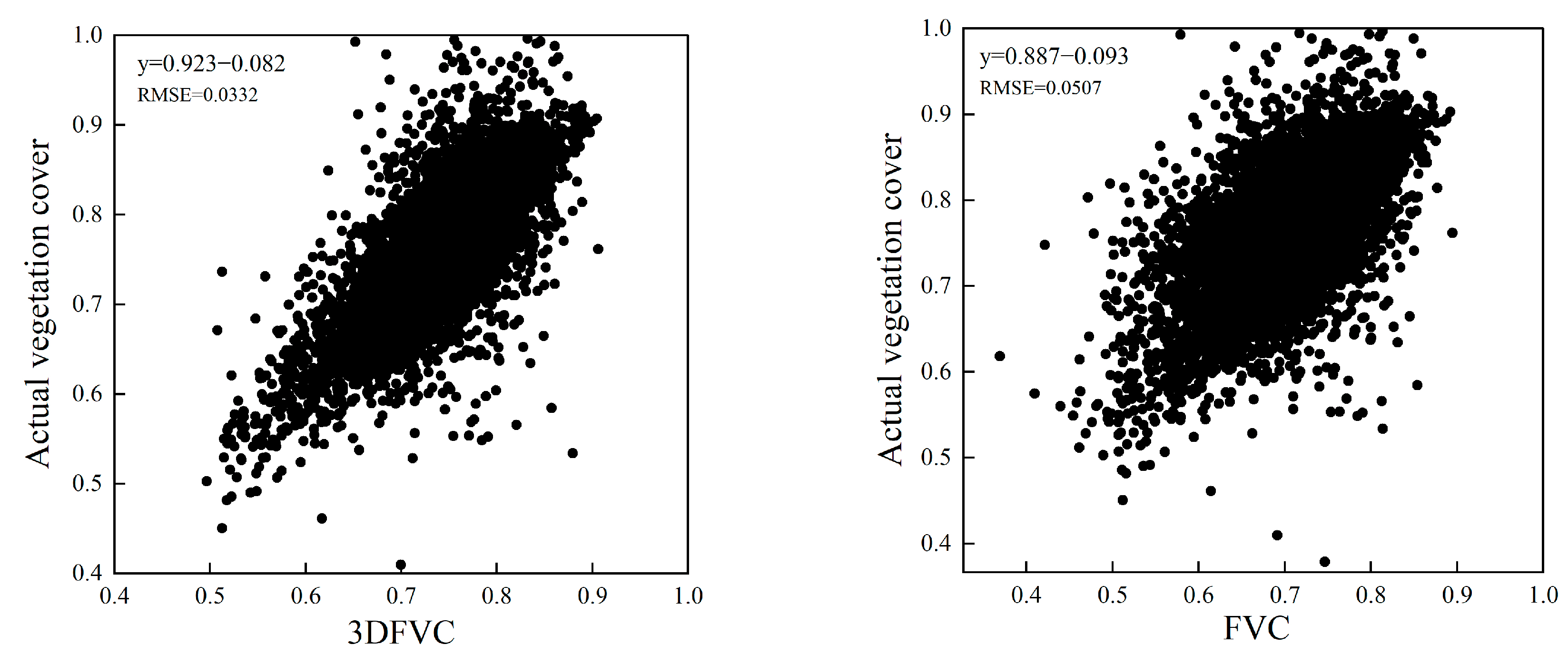
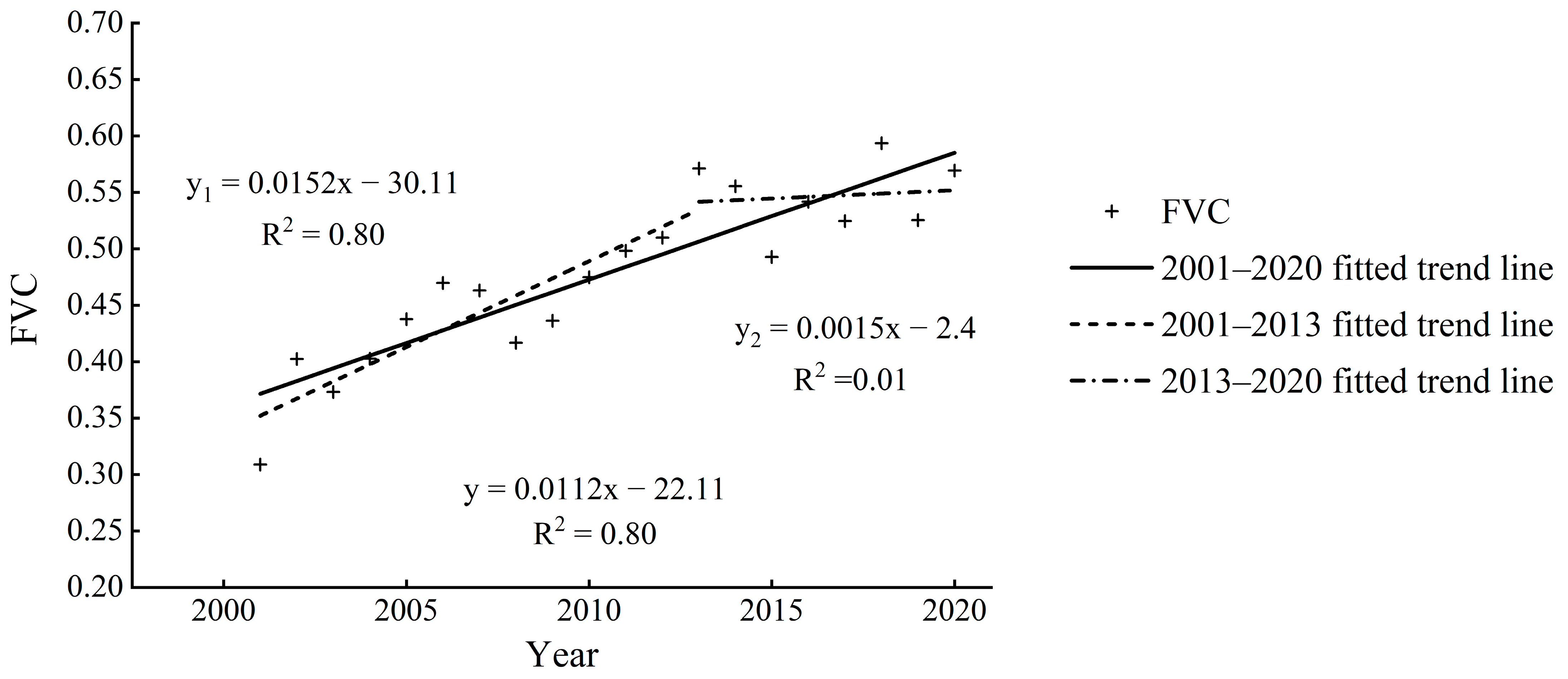
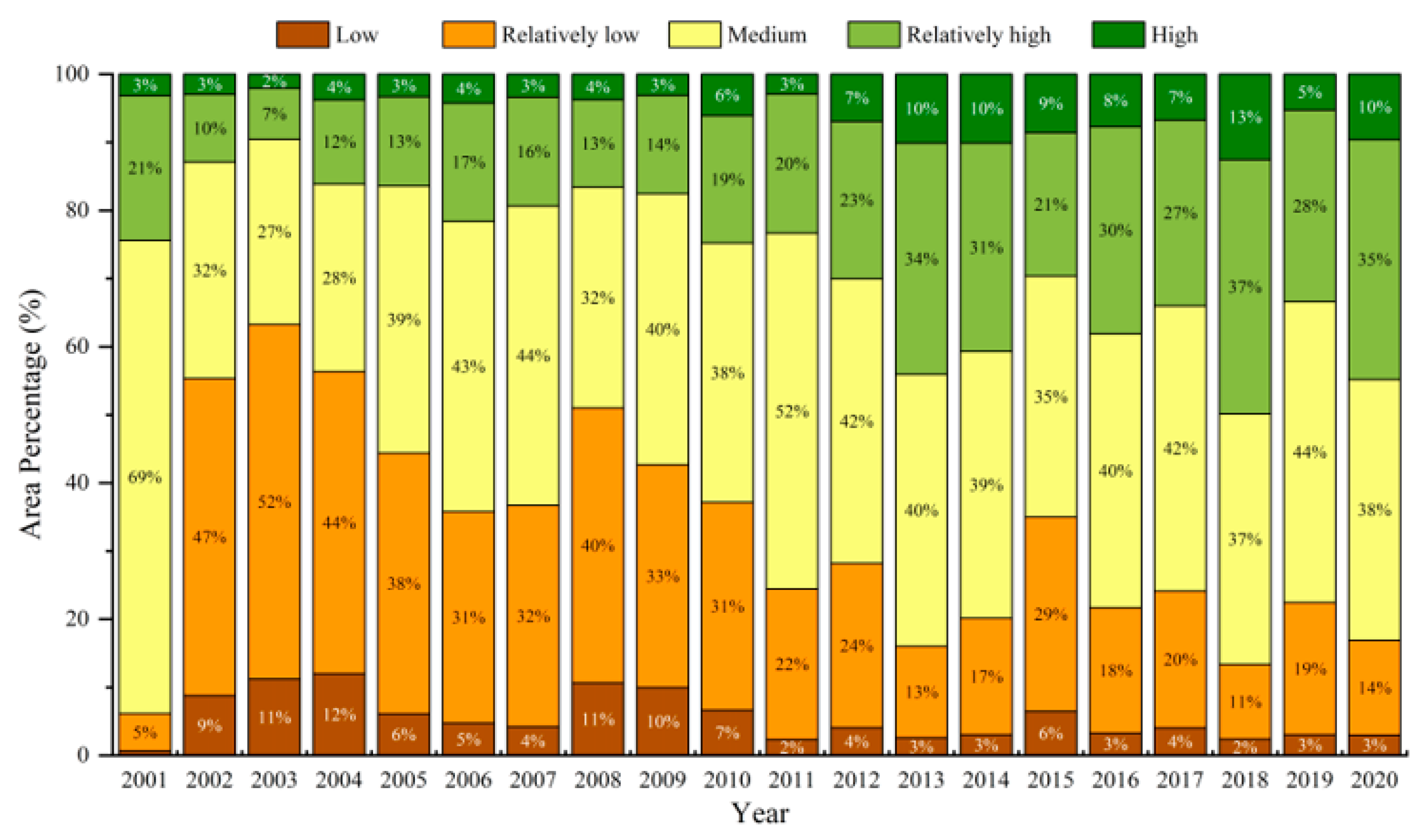
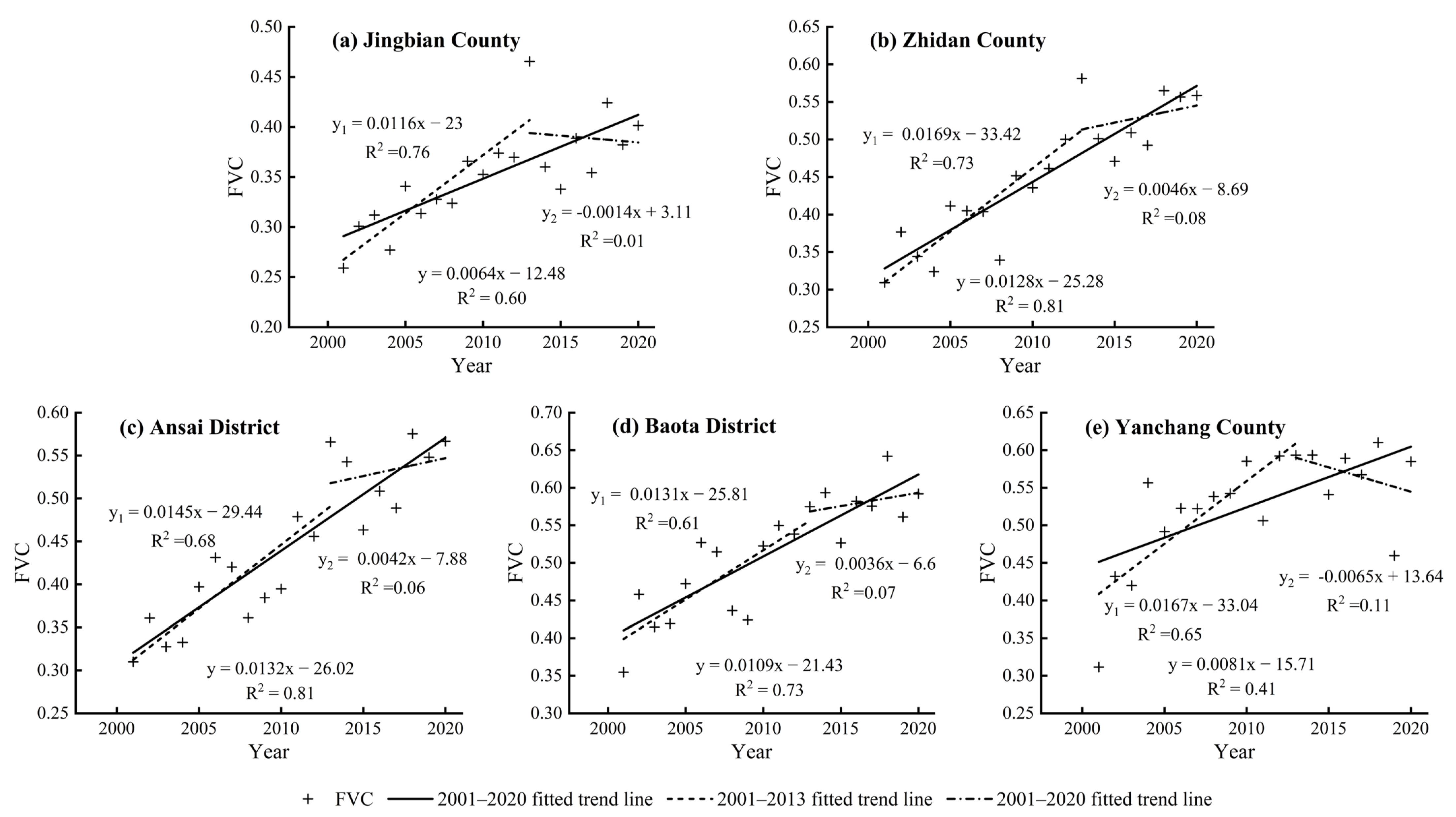
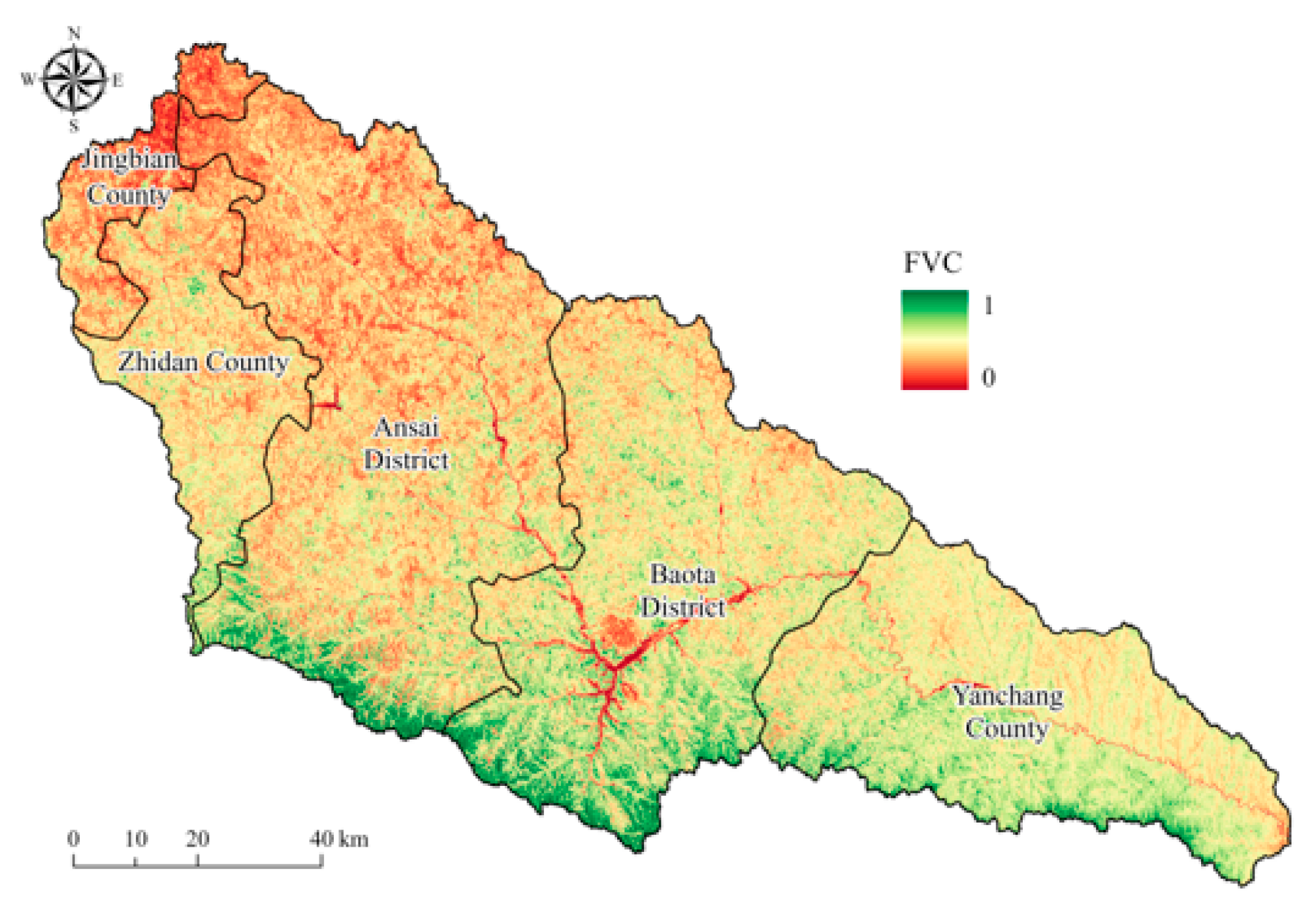
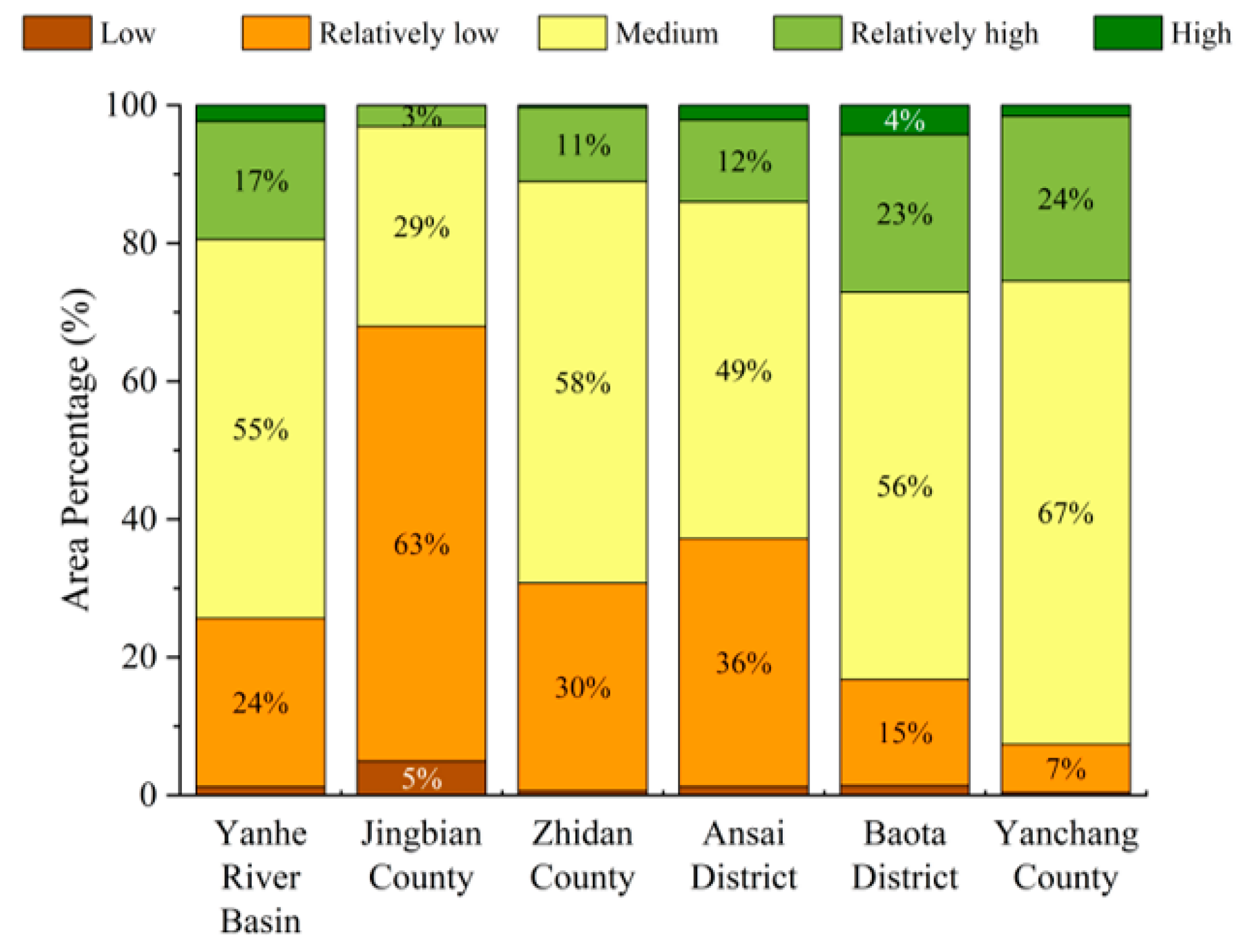
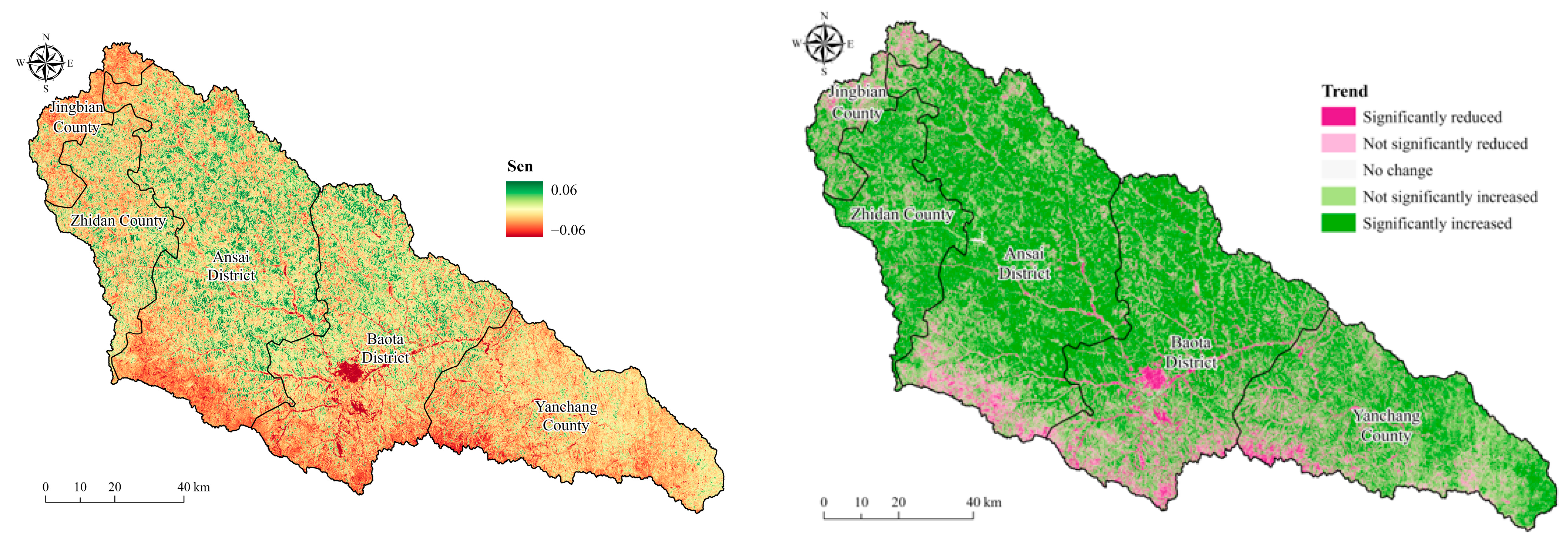
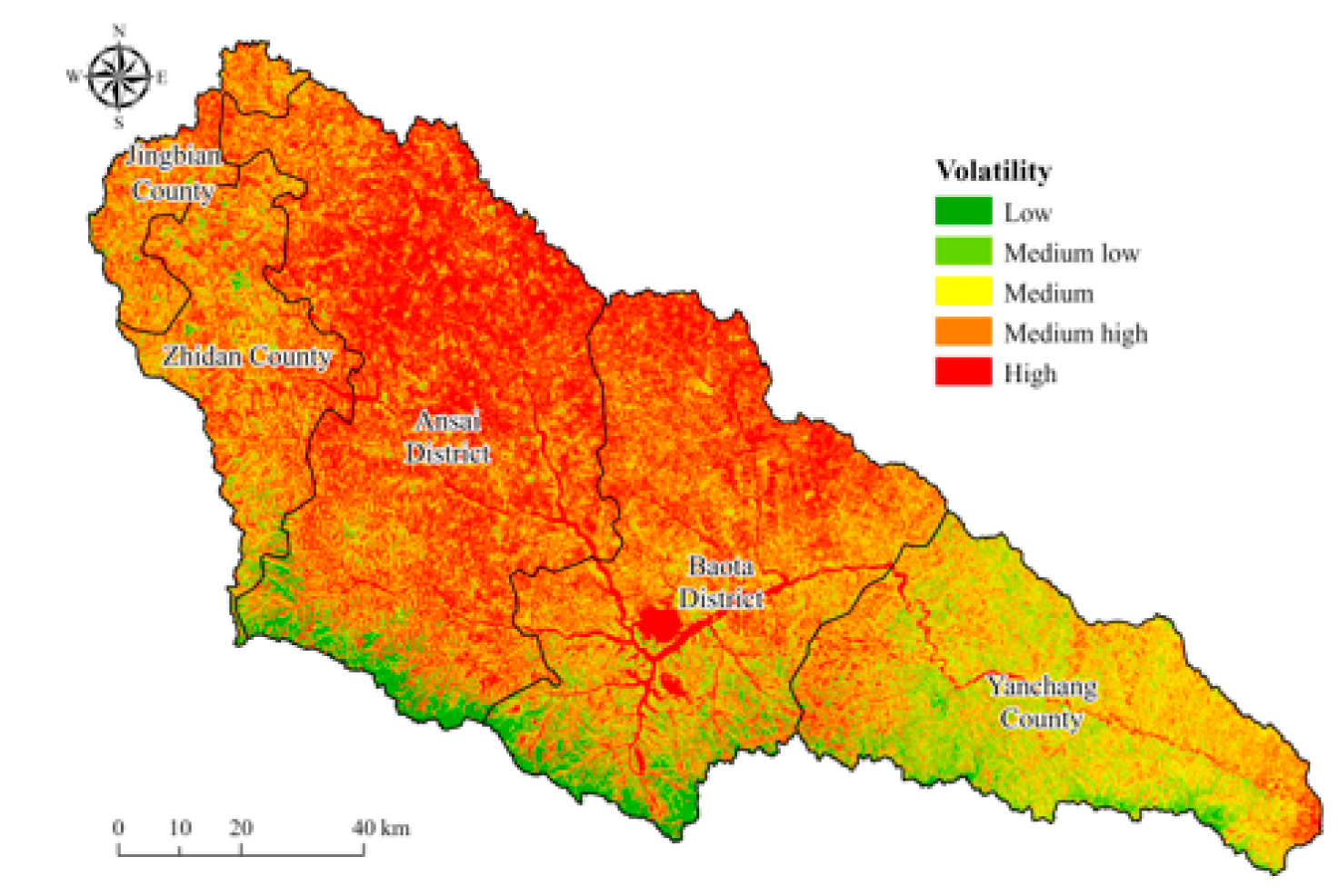

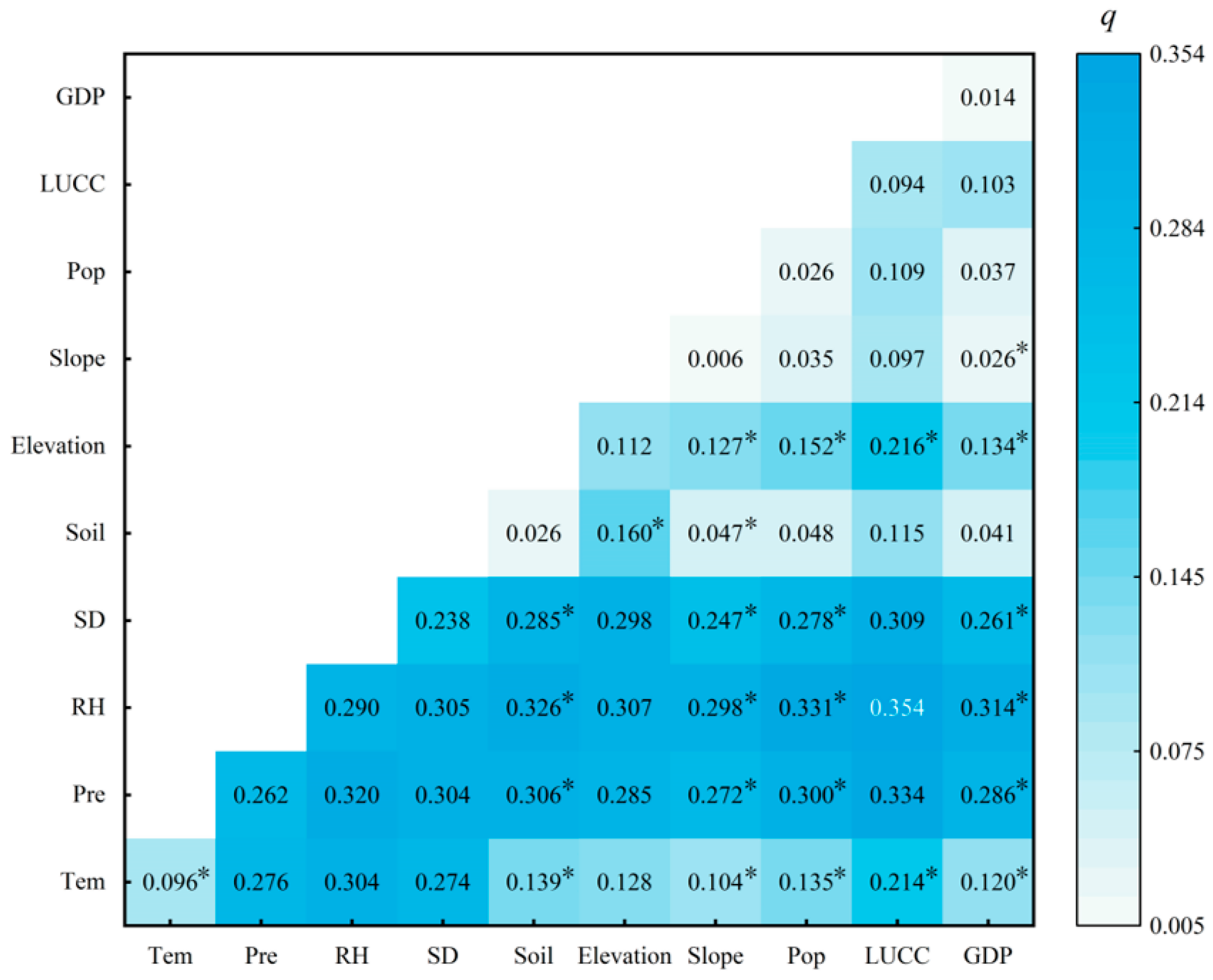

| Data Category | Data Name | Data Products | Resolution | Data Source |
|---|---|---|---|---|
| Image | MODIS | MOD13Q1-NDVI | 250 m | Google Earth Engine (https://earthengine.google.com/, accessed on 22 March 2023) |
| Landsat | Landsat 5/7/8 Surface Reflectance Tier 1 | 30 m | ||
| Meteorological data | Temperature | GPRChinaTemp1 km [27] | 1 km | Zenodo (https://zenodo.org/, accessed on 22 March 2023) |
| Precipitation | ||||
| Relative humidity | China Relative Humidity Dataset | National Earth System Science Data Center (www.geodata.cn, accessed on 22 March 2023) | ||
| Sunshine hours | China Sunshine Hours Dataset | |||
| Surface data | Soil | Soil Type | 1 km | Resource and Environmental Science Data Center (www.resdc.cn, accessed on 22 March 2023) |
| DEM | NASADEM | 30 m | EARTHDATA (www.earthdata.nasa.gov, accessed on 22 March 2023) | |
| Human activity data | Population density | LandScan Global | 1 km | LandScan (landscan.ornl.gov, accessed on 22 March 2023) |
| GDP | ChinaGDP [28] | Zenodo (https://zenodo.org/, accessed on 22 March 2023) | ||
| LUCC | CLCD [29] | 30 m |
| Class | Classification Criteria |
|---|---|
| Low | 0 ≤ 3DFVC < 0.2 |
| Relatively low | 0.2 ≤ 3DFVC < 0.4 |
| Medium | 0.4 ≤ 3DFVC < 0.6 |
| Relatively high | 0.6 ≤ 3DFVC < 0.8 |
| High | 0.8 ≤ 3DFVC < 1 |
| Class | Classification Criteria |
|---|---|
| Low variation | ≤ 0.05 |
| Relatively low variation | ≤ 0.10 |
| Medium variation | ≤ 0.15 |
| Relatively high variation | ≤ 0.20 |
| High variation | > 0.20 |
| Type of Trend Change | Judgment Basis |
|---|---|
| Anti-Continuity | 0 < H < 0.5 |
| Independence | H = 0.5 |
| Sustainability | 0.5 < H < 1 |
| Detector Type | Function |
|---|---|
| Factor detector | Investigating the spatial heterogeneity of Y and its dependence on factor X |
| Interaction detectors | Interaction between different influences on X and independent variables was identified |
| Risk detector | Determining the significance of the difference in the mean values of the attributes between the two subregions |
| Ecological detector | Comparing the significance of the difference between the effects of factors X1 and X2 on the spatial distribution of attribute Y |
| Factor Category | Driving Factor | Unit |
|---|---|---|
| Meteorological factor | Temperature | °C |
| Precipitation | mm | |
| Relative humidity | % | |
| Sunshine hours | h | |
| Surface factor | Soil | - |
| DEM | m | |
| Slope | ° | |
| Human activity factor | Population density | persons/km2 |
| GDP | million CNY | |
| LUCC | - |
| 2001 | 2020 | ||||||
|---|---|---|---|---|---|---|---|
| Low | Relatively Low | Medium | Relatively High | High | Total | Transfer out | |
| Low | 36.80 | 4.19 | 5.17 | 2.83 | 0.56 | 49.55 | 12.75 |
| Relatively low | 17.67 | 123.39 | 153.56 | 102.62 | 22.15 | 419.40 | 296.00 |
| Medium | 118.72 | 775.34 | 2204.43 | 1788.05 | 424.64 | 5311.18 | 3106.76 |
| Relatively high | 52.45 | 150.26 | 520.22 | 694.47 | 208.22 | 1625.62 | 931.15 |
| High | 2.11 | 9.97 | 44.63 | 104.94 | 79.20 | 240.85 | 161.65 |
| Total | 227.76 | 1063.16 | 2928.00 | 2692.92 | 734.76 | ||
| Transfer to | 190.96 | 939.77 | 723.58 | 1998.45 | 655.57 | ||
| Amount of change | 178.21 | 643.76 | −2383.18 | 1067.29 | 493.91 | ||
| Factor | Tem | Pre | RH | SD | Soil | Elevation | Slope | Pop | LUCC | GDP |
|---|---|---|---|---|---|---|---|---|---|---|
| q | 0.096 | 0.262 | 0.290 | 0.238 | 0.026 | 0.112 | 0.006 | 0.026 | 0.094 | 0.014 |
| p | 0.000 | 0.000 | 0.000 | 0.000 | 0.000 | 0.000 | 0.000 | 0.000 | 0.000 | 0.000 |
| Factor | Tem | Pre | RH | SD | Soil | Elevation | Slope | Pop | LUCC | GDP |
|---|---|---|---|---|---|---|---|---|---|---|
| Tem | ||||||||||
| Pre | Y | |||||||||
| RH | Y | Y | ||||||||
| SD | Y | N | Y | |||||||
| Soil | Y | Y | Y | Y | ||||||
| Elevation | N | Y | Y | Y | Y | |||||
| Slope | Y | Y | Y | Y | Y | Y | ||||
| Pop | Y | Y | Y | Y | N | Y | Y | |||
| LUCC | Y | Y | Y | Y | Y | Y | Y | Y | ||
| GDP | Y | Y | Y | Y | N | Y | N | Y | Y |
| 2001 | 2020 | ||||||||
|---|---|---|---|---|---|---|---|---|---|
| Cropland | Forest | Shrub | Grassland | Water | Barren | Impervious | Total | Transfer out | |
| Cropland | 499.24 | 43.50 | 0.20 | 383.36 | 0.75 | 0.15 | 23.23 | 950.43 | 451.18 |
| Forest | 2.74 | 502.26 | 0.20 | 1.25 | 0.00 | 0.00 | 0.03 | 506.47 | 4.22 |
| Shrub | 0.07 | 6.87 | 0.97 | 5.45 | 0.00 | 0.00 | 0.00 | 13.36 | 12.39 |
| Grassland | 315.55 | 730.08 | 5.30 | 5060.30 | 1.03 | 0.50 | 10.06 | 6122.83 | 1062.53 |
| Water | 0.48 | 0.05 | 0.00 | 0.09 | 2.62 | 0.00 | 0.31 | 3.56 | 0.94 |
| Barren | 0.01 | 0.00 | 0.00 | 0.04 | 0.00 | 0.00 | 0.01 | 0.07 | 0.06 |
| Impervious | 0.01 | 0.00 | 0.00 | 0.00 | 0.02 | 0.00 | 26.58 | 26.61 | 0.03 |
| Total | 818.10 | 1282.76 | 6.66 | 5450.50 | 4.43 | 0.66 | 60.21 | ||
| Transfer to | 318.85 | 780.51 | 5.70 | 390.19 | 1.81 | 0.66 | 33.64 | ||
| Amount of change | −132.33 | 776.29 | −6.69 | −672.34 | 0.87 | 0.59 | 33.61 | ||
| Factor | Suitable Type or Range of FVC | FVC |
|---|---|---|
| Tem | 9.9–10.5 °C | 0.797 |
| Pre | 620–634 mm | 0.811 |
| RH | 56–57% | 0.834 |
| SD | 18.6–19.3 h | 0.821 |
| Soil | Black clay | 0.824 |
| Elevation | 1088–1205 m | 0.794 |
| Slope | 22–27° | 0.766 |
| Pop | 0–1122 persons/km2 | 0.762 |
| LUCC | Shrub | 0.834 |
| GDP | 0–18.7 million CNY | 0.760 |
Disclaimer/Publisher’s Note: The statements, opinions and data contained in all publications are solely those of the individual author(s) and contributor(s) and not of MDPI and/or the editor(s). MDPI and/or the editor(s) disclaim responsibility for any injury to people or property resulting from any ideas, methods, instructions or products referred to in the content. |
© 2023 by the authors. Licensee MDPI, Basel, Switzerland. This article is an open access article distributed under the terms and conditions of the Creative Commons Attribution (CC BY) license (https://creativecommons.org/licenses/by/4.0/).
Share and Cite
He, Z.; Yue, T.; Chen, Y.; Mu, W.; Xi, M.; Qin, F. Analysis of Spatial and Temporal Changes in Vegetation Cover and Driving Forces in the Yan River Basin, Loess Plateau. Remote Sens. 2023, 15, 4240. https://doi.org/10.3390/rs15174240
He Z, Yue T, Chen Y, Mu W, Xi M, Qin F. Analysis of Spatial and Temporal Changes in Vegetation Cover and Driving Forces in the Yan River Basin, Loess Plateau. Remote Sensing. 2023; 15(17):4240. https://doi.org/10.3390/rs15174240
Chicago/Turabian StyleHe, Zhilin, Tianming Yue, Yanglong Chen, Weichen Mu, Mengfei Xi, and Fen Qin. 2023. "Analysis of Spatial and Temporal Changes in Vegetation Cover and Driving Forces in the Yan River Basin, Loess Plateau" Remote Sensing 15, no. 17: 4240. https://doi.org/10.3390/rs15174240
APA StyleHe, Z., Yue, T., Chen, Y., Mu, W., Xi, M., & Qin, F. (2023). Analysis of Spatial and Temporal Changes in Vegetation Cover and Driving Forces in the Yan River Basin, Loess Plateau. Remote Sensing, 15(17), 4240. https://doi.org/10.3390/rs15174240












